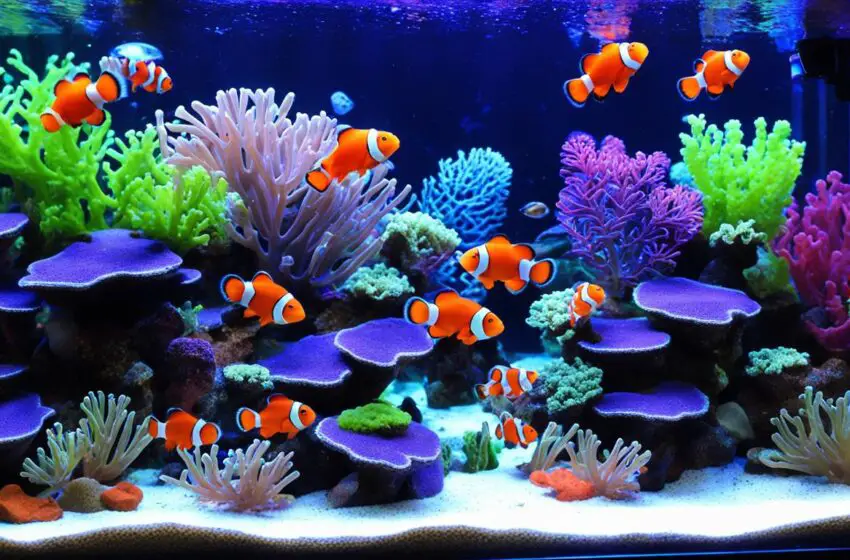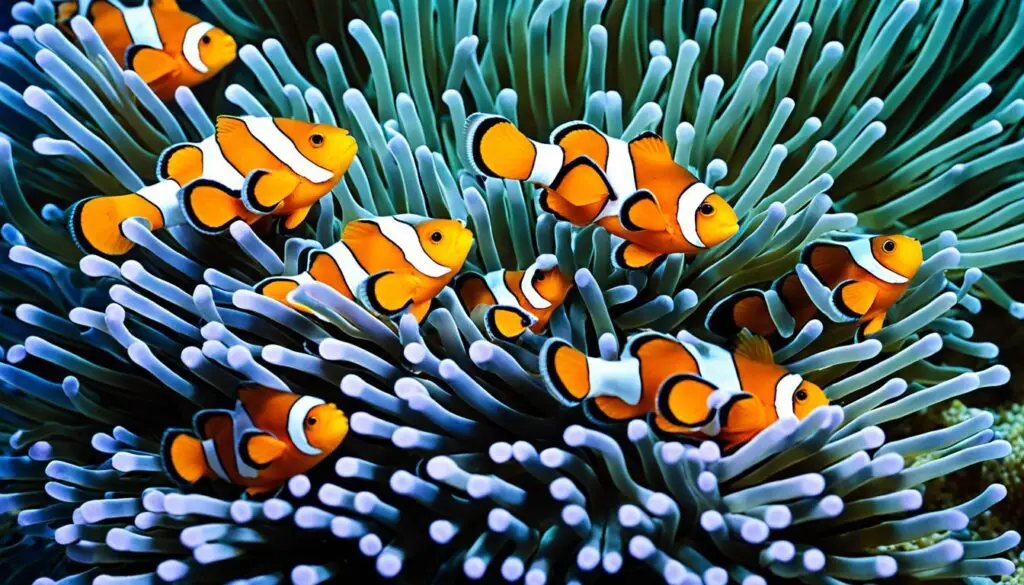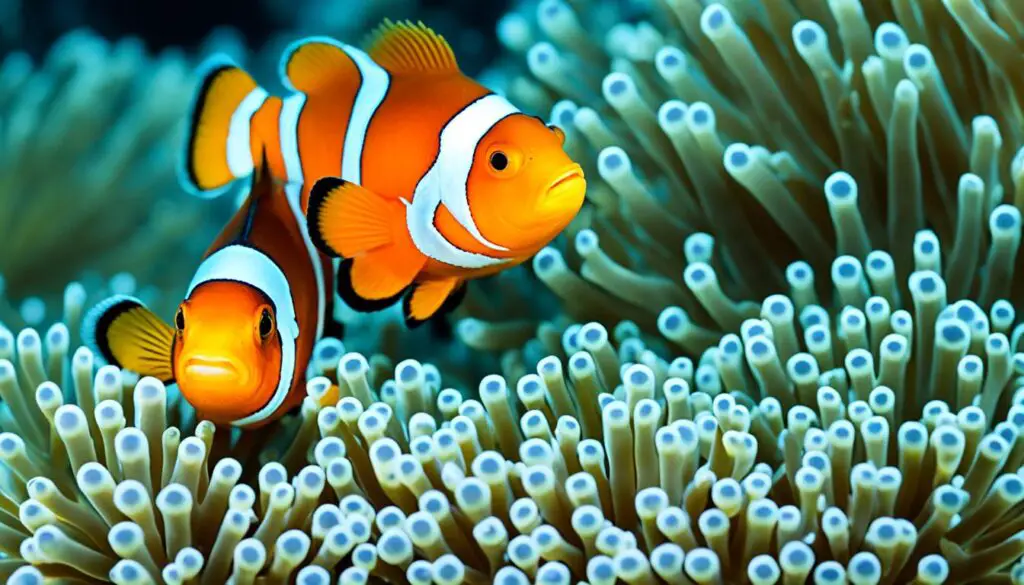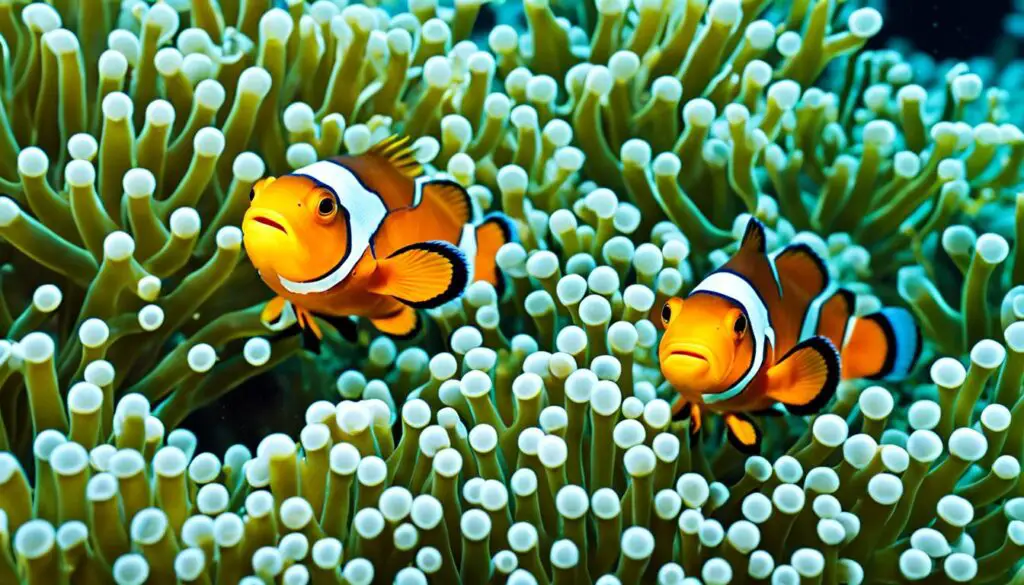The Ultimate Guide to Clownfish Aquariums: Setup and Maintenance

Welcome to the ultimate guide on clownfish aquariums! If you love colorful and hardy clownfish, you’re in the right spot. Creating a healthy and happy home for them is key. Let’s look at what it takes to setup and maintain a perfect environment for your clownfish.
Key Takeaways:
- A minimum tank size of 40 liters is recommended for clownfish.
- Essential equipment includes a tank, sand, live rock, filter, circulation pump, and heating.
- Position the tank away from direct sunlight and maintain proper cleaning practices.
- Complete the crucial nitrogen cycle process before adding clownfish to the tank.
- Implement regular maintenance routines such as temperature checks, feeding, and water changes to keep the tank healthy.
Learn About Clownfish: Range, Natural Habitat, and Social Hierarchy
Clownfish live in the Eastern Indian Ocean and the Western Pacific. They stay in shallow areas near reefs and lagoons. Here, they team up with sea anemones. Clownfish form complex groups where the top pairs are in charge of making babies.
All clownfish start as males. But, when they find a partner, some become females. This switch is fascinating about these fish. The ocellaris, or common clownfish, is a favorite because of its bright orange look.

Knowing about clownfish’s home is key for making a good tank. When a tank is like their real home, you can see how cool they are. Their habits and ways are interesting to watch.
Tankmates, Diet, and Breeding of Clownfish
Clownfish tankmates add vibrancy to your aquarium. These colorful fish are peaceful with most. They get along with dwarf and large angelfish, blennies, and gobies. But, keep them separate from different clownfish species because they can be territorial.
Clownfish love both plants and small animals. A good diet for them includes pellets, frozen shrimp, and algae. Providing these foods will keep them healthy and happy.
Breeding clownfish at home is a rewarding hobby. You need the right clownfish pairs to breed successfully. The male takes care of the eggs until they hatch. This ensures new baby fish are safe and healthy.
It’s important to know how to keep clownfish happy and safe in your aquarium. Choose the right friends for them. Feed them a variety of good foods. And, learn how to help them have babies. This way, your aquarium will be a great place for these amazing fish.
FAQ
How big should a clownfish tank be?
A tank size of at least 40 liters is best for clownfish.
What equipment do I need to set up a clownfish aquarium?
To start, you’ll need a tank, water, sand, and live rock. Also, include a filter, pump for circulation, and a heater.
Where should I position my clownfish tank?
Place the tank where it won’t get direct sunlight.
What is the nitrogen cycle and why is it important?
The nitrogen cycle keeps the fish’s environment healthy. It must finish before adding fish to the tank.
How often should I clean the clownfish tank?
Cleaning should be part of your routine. Keep the temperature steady, feed the fish, and change the water weekly.
Where are clownfish found in the wild?
Clownfish are in lagoons and reefs. They live from the Eastern Indian Ocean to the Western Pacific.
Do clownfish have any social hierarchy in the wild?
In the wild, clownfish have a set social order. Some pairs play a big role in making babies.
Can different clownfish species be kept together in a tank?
It’s not a good idea to mix clownfish species. They might fight over territory.
What are suitable tankmates for clownfish?
Good friends for clownfish are some types of angelfish, blennies, and gobies. Also, non-aggressive fish get along well with them.
What do clownfish eat?
These fish like both plant and animal foods. Offer them pellets, frozen food, and algae.
Can clownfish be bred in captivity?
Clownfish breeding is successful for many people. Watching the male protect the eggs is a joy for fish lovers.



